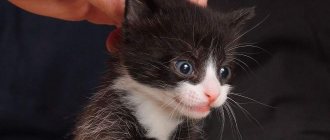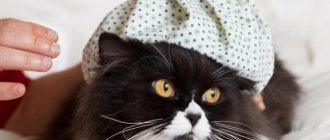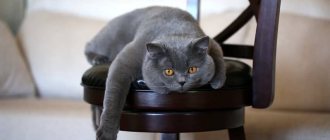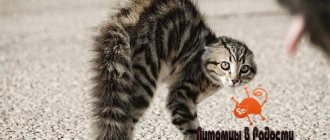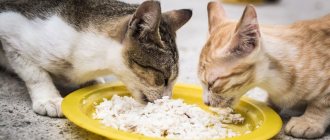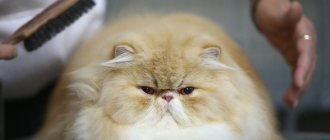Why does a runny nose occur in cats?
A runny nose in cats can occur due to a cold. If your pet has been exposed to a draft or has been in a cool room for a long time, then most likely this is the cause of rhinitis. Additionally, the symptom occurs when exposed to any allergen: food, chemical, parasitic.
Another cause of a runny nose is considered to be viral and bacterial infections, which can penetrate the nasal mucosa of a pet with a weakened immune system. Normally, a cat’s body resists pathogens, but if some kind of failure occurs, a characteristic disease occurs.
A cat's runny nose may be due to a cold.
Less commonly, rhinitis appears under the influence of fungal flora, which affects not only the skin, but also the mucous membranes. The provoking factor for the occurrence of the symptom can be a neoplasm that forms in the nasal cavity. Additional reasons:
- diabetes;
- congenital anomalies of the nasopharynx;
- inflammatory process occurring in the middle ear;
- injury to the mucous membrane.
It is not possible to determine the triggering factor for a runny nose at home, so you should consult a doctor immediately after the symptom appears.
Causes of rhinitis in a pet - video
Symptoms and diagnostic features
Symptoms that may accompany rhinitis in a pet:
- lacrimation;
- discharge of mucus from the nose;
- lethargy;
- decreased appetite;
- increase in body temperature.
If the symptom is triggered by an allergy, then itching, swelling and redness of the skin and mucous membranes may additionally be present. Bacterial rhinitis is characterized by purulent nasal discharge. In this case, the animal often develops a fever and practically does not get up. The introduction of a viral or fungal infection is also accompanied by copious mucous discharge from the nose and fever.
If, in addition to a runny nose, the cat is itching, this may indicate an allergy.
If parasites are present, the symptom does not go away for a long time and cannot be treated. Additionally, a cough may develop, appetite may worsen, and the pet will lose weight. With congenital anomalies in the development of the nasopharynx, a runny nose is present from the very birth of the kitten and accompanies it throughout its life.
What research methods help identify the cause of rhinitis:
- Allergy tests. This diagnostic method allows you to identify the provoking factor. To do this, small incisions are made on the pet’s skin, then various types of substances are applied and the reaction is monitored. This method is relevant only if the allergic nature of rhinitis is suspected.
- Examination of the nasal cavity. This type of study allows you to identify a foreign body or tumor. In this case, the doctor uses a special optical instrument.
- Blood and urine analysis. This method makes it possible to determine the inflammatory process, diabetes mellitus, and other diseases by characteristic signs. With abnormalities in the blood, the level of leukocytes, erythrocyte sedimentation rate and the amount of glucose increase. Protein and stone crystals may appear in the urine. In addition, the urine becomes cloudy and may contain bacteria and fungi.
- Skin examination. If the doctor detects any abnormalities, he may additionally perform a scraping to identify fungal microflora. A Wood's lamp is also used, with which it is easy to detect microsporia and other lesions of the epidermis.
- Stool analysis. This study allows you to identify parasite eggs and helminth fragments that can provoke the appearance of symptoms.
- Ultrasound of internal organs. This method of examination makes it possible to exclude damage to the kidneys and digestive organs and to identify possible disturbances in the functioning of the heart. If there are a large number of parasites in the pet’s body, they can be visualized in the intestines in the form of dark spots.
An important method is an examination by a veterinarian, which will identify the first signs of dangerous pathologies.
Attention! If a runny nose is a consequence of diabetes or tumors, then the animal’s condition only worsens over time, and standard treatment methods remain powerless.
Therapeutic tactics
If a runny nose is caused by a common cold caused by hypothermia of the pet’s body, then you can use time-tested methods, one of which is warming up. To do this, heat sea salt in a frying pan, let it cool slightly and put it in a handkerchief. Apply the resulting bag warm to your pet’s nose and trim for several minutes. It is recommended to repeat the procedure daily for 5–7 days. Heat can be used for therapy only in the absence of bacterial flora.
Sea salt can be used to warm your pet's nose
You can also use aloe juice to eliminate rhinitis. In this case, you need to select the lowest leaf and put it in the refrigerator for half an hour, after wrapping it in parchment paper. Then rinse thoroughly and cut, carefully squeezing the juice into a glass container.
The healing liquid should be injected into the pet’s nose, one drop at a time, using a pipette. It is enough to carry out the procedure 1-2 times a day. The course of treatment should not exceed a week. If, while using aloe juice, the symptoms intensify and discharge from the eyes appears, then it is recommended to try another method.
Aloe has an anti-inflammatory effect
A good remedy to speed up recovery is beet juice. To obtain it, just rinse a small root vegetable and grate it. Then transfer the resulting mass to cheesecloth and squeeze the juice into a glass container. Use 2 times a day, 1 drop in each nasal passage for 5 days. It is not recommended to increase the dosage of juice, otherwise you may provoke unwanted reactions.
Beetroot juice speeds up recovery from a runny nose
You can use saline solution for rinsing. It is enough to inject 2-3 drops into each nostril 2-3 times a day. Treatment can be stopped after the symptoms of rhinitis completely disappear. In combination, you can use the drug Glazolin 1 time before bedtime. One drop into each nasal passage is enough to significantly ease your pet's breathing. The course of treatment with this drug should not exceed 5 days, otherwise it can cause addiction to the drug.
Glazolin relieves nasal congestion
If it is difficult for your pet to breathe due to excessive mucous secretions, then children's Naphthyzin can be used for therapy, which constricts the vessels of the nasal mucosa. In this case, it is enough to inject one drop into each nostril. It is prohibited to use this medicine for more than 4–5 days. The drug can be instilled only once a day to avoid drying out the mucous membrane.
Naphthyzin constricts blood vessels, relieving swelling of the mucous membrane
If the symptom occurs as a result of injury to the nose, then no special treatment is required. Rhinitis will go away immediately after the wound heals. However, to speed up this process, it is recommended to treat the damaged surface with Miramistin 2 times a day until complete healing. The procedure should be carried out using a cotton swab, and rinsing the nose should be done using a pipette.
Miramistin is active against bacteria, viruses and fungi
Attention! If the symptoms of rhinitis do not stop within a week, this may indicate a bacterial or viral nature of the disease.
How do cats heal us? Some irrefutable evidence
Fact number 1. All mustaches feel when you need their help. They immediately begin to lie down or sit on the place that hurts you, or they put their paws on it. Even if your pet clings to you and wants affection, do not drive her away, the cat wants to help you.
Fact number 2. All cats know how to warm our body, but for treatment they know how to use another positive healing mechanism on sore spots - to purr or purr loudly. This is how the animal cures depression, stress, apathy, improves human muscle tissue, and helps the rapid restoration of cells and bones. This fact was proven by the teachings themselves, who were able to clearly determine the reason for the animal’s rumbling and the frequency of its vibration. When cats purr, vibration occurs, at forty hertz of which scientists have detected the strongest, healing waves!
Fact number 3. Treatment with cats occurs through a strong bioenergetic exchange between the pet itself and its mistress or owner. It’s not you who should like the cat, but the cat who should like you, because if an animal loves its owner, then it is ready to give him enough bioenergy so that it is enough for his full recovery.
Fact number 4. Children with cerebral palsy, as well as adults with pathologies of the musculoskeletal system, are treated with cats a little differently. They repeatedly rub against a person’s limbs, which do not move, begin to rumble or purr loudly, and lick them, thus providing the necessary massage.
A few more proven facts. Cats calm small children who are capricious for hours on end, and for those who cannot live without drinking and drugs, animals help cope with withdrawal symptoms.
And all cats, regardless of what breed and color, have such energy that has a positive effect on the organs of the cardiovascular system, helps reduce high blood pressure, get rid of severe headaches and even... make cuts, wounds and bruises quickly were healing.
Even if it has not yet been fully proven how pets manage to treat humans, and why each breed of these animals is intended to treat “its own human organ” or this or that disease, one thing is important, the process of “treatment” will be pleasant for everyone. Even if, after undergoing “cat therapy,” you still have to visit a doctor, then don’t even doubt it, any doctor will tell you, after a thorough examination, that you are much better!
How to treat viral and bacterial runny nose
If rhinitis occurs against the background of a viral infection, then drugs that can suppress the activity of pathogens and stimulate the body’s defenses are used for treatment. Such medications include Interferon, Grippferon and other similar drugs. These medications are used for administration into the nasal cavity, one drop at a time. Immunostimulants can be used for no more than a week and after consultation with a doctor. Rarely, during therapy with antiviral drugs, digestive disorders and pain in the liver area may occur, so it is dangerous to determine the dosage without consulting a doctor.
Grippferon stimulates the immune system
To speed up recovery from viral infections, Forvet, Feliferon and other drugs that increase the body's defenses are used. These medications are prescribed for a course of 7 to 10 days. These drugs are administered by injection in a hospital setting once a day. Injections can also be given at home, provided you have the skills. If after the injection the animal begins to limp, then the manipulation was performed incorrectly.
Forvet has an antiviral effect
In case of bacterial etiology of the disease, tetracycline antibiotics are used for treatment: Doxycycline, Tetracycline, etc. Fluoroquinolones can also be prescribed: Levofloxacin, Ciprofloxacin, etc. These drugs are intended for oral administration. Antibiotics are used only in dosages prescribed by the doctor, which depend on body weight and the characteristics of the infection. The course of treatment does not exceed 5–7 days. Antimicrobial drugs can provoke digestive disorders, diarrhea and vomiting, so they can be used only after confirmation of the diagnosis.
Doxycycline kills a wide range of microorganisms
Additionally, Streptocide is often used to speed up recovery. To do this, you need to first dilute 1 sachet (4 g) in 100 ml of water and let the liquid stand for about two hours. Then you can use it for instillation 3 times a day. The course of treatment should not exceed 5 days. One drop should be administered into each nostril, no more. Streptocide can only be used for a short course, because long-term treatment can lead to unwanted reactions from the pet’s body. In this case, visual impairment often occurs.
Streptocide relieves the inflammatory process
Attention! Without a preliminary examination by a specialist, it is not recommended to treat bacterial and viral types of runny nose on your own. If the tactics are incorrect, complications can arise.
What not to do
In order not to provoke complications and achieve results in treatment, it is important to follow the following rules:
- Do not give antibiotics without a doctor's prescription.
- get rid of the smells of household chemicals and other heavy odors in the apartment.
- do not increase the safe period of treatment.
- You cannot let the animal go outside.
- Do not give dry food if you have diarrhea.
Vet
For safe treatment, you should always contact a professional. This condition will allow you to avoid complications and cure your cat in the most painless way possible. The doctor will tell you exactly what you can give your cat for diarrhea and will draw up a treatment plan and identify the cause of the poor health. Your pet may need a special diet or nutrition plan.
Treatment of rhinitis caused by fungi, parasites and allergens
The fungal flora that most often provokes rhinitis is called cryptococcal. To eliminate it, Itraconazole, Fluconazole and other similar drugs are prescribed. The amount of medication depends on the weight of the cat, and the course of treatment is long and lasts at least a month. The first drug is prescribed at a dose of 5 mg per kg once a day. The second medicine must be given to the pet twice a day, 50 mg. The required amount must be dissolved in 1 tsp. boiled water and pour into the animal’s mouth on an empty stomach.
During therapy with antifungal drugs, a cat's appetite may worsen, digestive problems may occur, as well as nausea and vomiting. If such symptoms appear, you should notify your doctor to adjust the dosage.
Fluconazole is active against fungal flora
To eliminate a runny nose caused by parasites, special drops are used on the withers, which can get rid of helminths, as well as fleas, ticks and lice-eaters. Such products should be used once. After 24 hours, all parasites will leave the pet’s body. Drops are applied to the skin, spreading the fur in the withers area. Most often, Dironet, Prazicide, Bars and others are used for treatment. Drops applied to the skin are generally well tolerated. Only occasionally may the pet feel worse and become lethargic.
Dironet gets rid of parasites
If a symptom occurs against the background of an allergy, then it is important to identify the provoking factor and eliminate it. Antihistamines are also used additionally for treatment: Suprastin, Zodak, Tavegil, etc. It should be remembered that these medications do not eliminate allergies, but only relieve symptoms. It is enough to give the animal a quarter of a tablet per day on an empty stomach. The course of treatment should not exceed 7 days. When treated with antihistamines, the pet may appear lethargic, which is caused by a slight sedative effect. After discontinuation of the drugs, the animal’s condition returns to normal.
Tavegil relieves allergy symptoms
It is recommended to provide your pet with rest during treatment. It is important to protect your cat from stress, monitor its diet and prevent hypothermia.
How to rid a cat of a runny nose - video
Treatment methods
Treatment cats have in their arsenal several tools that have an impact on the human condition.
Purring
Scientists believe that cats do not purr for their owner. Cats treat themselves first. Using the purring sound they strengthen bones and heal wounds.
The effect of purring on humans is scientifically explainable. Humans are 70% water. Any vibration causes the water in the cells to vibrate, which has a beneficial effect on the overall human condition. The rhythm of a cat's purring promotes the production of new cells in the body.
It has also been scientifically proven that the monotonous rhythm of purring has a calming effect on the nervous system and reduces anxiety in humans.
The domestic cat purrs in the range of 27-44 Hz. This purring is compared to the effect of ultrasound. And for this reason, cats heal people with a rhythmic vibrating sound:
- Promote faster tissue fusion during fracture (by 20%).
- Reduce pain in joint diseases (osteochondrosis, arthritis).
- Accelerate wound healing.
US scientists call the treatment of elderly people suffering from osteoporosis with cats successful.
In order to heal with purring, it is also permissible to use audio recordings of a cat’s voice.
Weasel or physiotherapist cat
When a person pets a cat, the effect is equivalent to physical therapy. Low frequency currents arise from the friction of fur hairs against each other. Contact with fur creates static electricity. The resulting currents affect the nerve endings, of which there are a lot on the palms. Nerve impulses travel further to the brain. Therefore, stroking animals has a positive effect on the state of the nervous system. Using cat's claws, which is similar to acupuncture, has the same effect.
Cats have soft, delicate fur and almost all of them love slow and long strokes. They get pleasure from it, and the person relaxes, feels a surge of tenderness, lonely people cease to feel like such.

